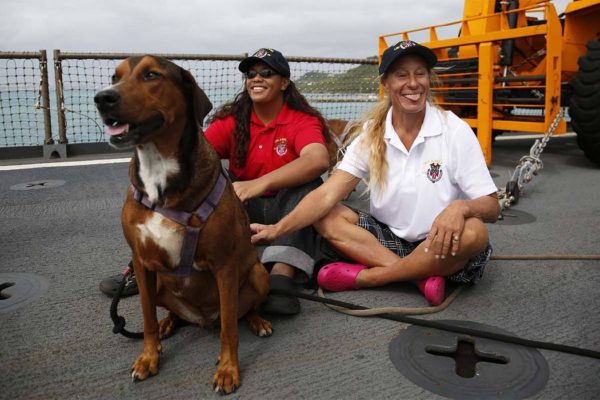

Jennifer Appel, right, and Tasha Fuiava sit with their dogs on the deck of the USS Ashland Monday, Oct. 30, 2017, at White Beach Naval Facility in Okinawa, Japan. The U.S. Navy ship arrived at the American Navy base, five days after it picked up the women and their two dogs from their storm-damaged sailboat, 900 miles southeast of Japan. (AP Photo/Koji Ueda)
U.S. Coast Guard spokesman Lt. Scott Carr told The Associated Press that their review of the incident and subsequent interviews with the survivors revealed that they had the Emergency Position Indicating Radio Beacon (EPIRB) aboard but never turned it on.
When asked if the two had the radio beacon aboard, the women told the AP on Friday they had a number of other communications devices, but they didn’t mention the EPIRB.
The device communicates with satellites and sends locations to authorities. It’s activated when it’s submerged in water or turned on manually.
During the post-incident debriefing by the Coast Guard, Jennifer Appel, who was on the sailboat with Tasha Fuiava, was asked if she had the emergency beacon on board. Appel replied she did, and that it was properly registered.
“We asked why during this course of time did they not activate the EPIRB. She had stated they never felt like they were truly in distress, like in a 24-hour period they were going to die,” said Coast Guard spokeswoman Petty Officer 2nd Class Tara Molle, who was on the call to the AP with Carr.
Carr also said the Coast Guard made radio contact with a vessel that identified itself as the Sea Nymph in June near Tahiti, and the captain said they were not in distress and expected to make land the next morning. That was after the women reportedly lost their engines and sustained damage to their rigging and mast.
Experts say some of the details of the women’s story do not add up.
A retired Coast Guard officer who was responsible for search and rescue operations said that if the women used the emergency beacon, they would have been found.
“If the thing was operational and it was turned on, a signal should have been received very, very quickly that this vessel was in distress,” Phillip R. Johnson said Monday in a telephone interview from Washington state.
Emergency Position Indication Radio Beacons, or EPIRBS, activate when they are submerged in water or turned on manually and send a location to rescuers within minutes.
The beacons are solid and built to be suddenly dropped in the ocean. “Failures are really rare,” Johnson said, but added that old and weak batteries also could cause a unit not to work.
It’s not clear if the pair had tested it before the journey.
The women also said they had six forms of communication that all went dead. “There’s something wrong there,” Johnson said.
He knows of cases in remote Alaska where a ship in distress just using one form of beacon brought a fairly quick response from nearby fishing boats and the Coast Guard.
“I’ve never heard of all that stuff going out at the same time,” he said.
more recommended stories
 Fentanyl Seizures at Border Continue to Spike, Making San Diego a National Epicenter for Fentanyl Trafficking
Fentanyl Seizures at Border Continue to Spike, Making San Diego a National Epicenter for Fentanyl TraffickingFentanyl Seizures at Border Continue to.
 Utah Man Sentenced for Hate Crime Attack of Three Men
Utah Man Sentenced for Hate Crime Attack of Three MenTuesday, August 8, 2023 A.
 Green Energy Company Biden Hosted At White House Files For Bankruptcy
Green Energy Company Biden Hosted At White House Files For BankruptcyAug 7 (Reuters) – Electric-vehicle parts.
 Former ABC News Reporter Who “Debunked” Pizzagate Pleads Guilty of Possessing Child pδrn
Former ABC News Reporter Who “Debunked” Pizzagate Pleads Guilty of Possessing Child pδrnFriday, July 21, 2023 A former.
 Six Harvard Medical School and an Arkansas mortuary Charged With Trafficking In Stolen Human Remains
Six Harvard Medical School and an Arkansas mortuary Charged With Trafficking In Stolen Human RemainsSCRANTON – The United States.
 Over 300 People Facing Federal Charges For Crimes Committed During Nationwide Demonstrations
Over 300 People Facing Federal Charges For Crimes Committed During Nationwide DemonstrationsThe Department of Justice announced that.



